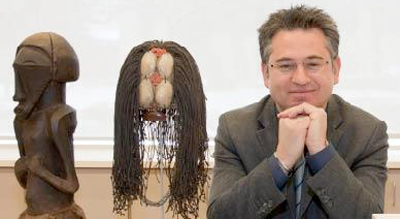by Daniel Hathaway

The Cleveland Chamber Music Society takes a slightly broader approach to its roster of speakers, which this season includes, to be sure, two certified musicologists (CWRU’s David Rothenberg and Bard’s Peter Laki) but also a well-known program annotator (Richard Rodda), a Rabbi (Roger Klein of The Temple-Tifereth Israel), an audiophile and WCLV program host (Eric Kisch), the editor of an online journal (me) and, next Tuesday, the Curator of African Art at the Cleveland Museum of Art (Constantine Petridis).
“This is my very first talk on music ever,” Costa Petridis told us by phone from St. Louis, where he was attending a conference, “so I’m a little bit nervous, but very excited about it too.”
The Belgian-born art scholar added, “I have given a lot of lectures in the visual arts, but it’s really quite new for me to do it in music. But what I am hoping to accomplish is to take a look beyond the pieces as such — because the program book does that to some extent — and tie them to broader historical concepts and specifically to the biographies of the composers, illustrated by musical examples.”
Petridis’s 6:30 pm lecture next Tuesday, April 8, precedes a 7:30 pm performance by the Pavel Haas Quartet (Veronika Jarůšková & Marek Zwiebel, violins, Pavel Nikl, viola & Peter Jarůšek, cello), who will play Janáček’s Quartet No. 1 “Kreutzer Sonata”, Britten’s Quartet No. 2 in C, op. 36 & Beethoven’s Quartet in e, op. 59, no. 2 on the Society’s series at Plymouth Church in Shaker Heights.
“I plan to concentrate on Britten and Janáček,” Petridis said. “They have a lot in common and Janáček is one of my favorite composers. I want to talk about how they relate to each other as composers in the history of the twentieth century and how their quartets have some elements in common. Both composers have unique and original voices and both are still a little underrated.”
Petridis will also make connections between the quartets and the composers’ vocal works, particularly those they wrote for the theater. “I’ll try to relate both quartets to operas they wrote about the same time. For Britten, it’s Peter Grimes, and for Janáček, Káťa Kabanová, although it’s perhaps an interesting coincidence that Janáček’s The Cunning Little Vixen that The Cleveland Orchestra is performing in May was written in the same year as the “Kreutzer Sonata” quartet (1923).
“In the case of Britten, the comparison is more about the music, and for Janáček, for the language it employs and the story line. The relationship between speech and music is quite explicit in Janáček’s instrumental music, and one writer has called the second Britten quartet a sequel to Peter Grimes.”
He’ll also explore other back stories. “Both quartets refer to music from the past. The Britten was written as a tribute to Henry Purcell, so I’d like to dwell on that a bit. The Janáček makes direct references to Beethoven’s “Kreutzer” Sonata and a literary reference to Tolstoy’s novel. I’ll play examples to illuminate those references and sources of inspiration, which are much more subtle and indirect.”
Though Costa Petridis will be making his debut as a pre-concert lecturer next Tuesday, he has been a frequent attendee. “I’ve been to a lot of them and have picked up inspiration here and there. The great thing is that the lecture series is so varied. Many different people speak and each approaches the subject in a different way. That leaves room for a lot of freedom and individual approaches to things.”
Coming on Monday: a conversation with Pavel Haas Quartet violist, Pavel Nikl.
Revised on 4/5/2014 to correct a reference in the fourth-to last paragraph.
Published on ClevelandClassical.com April 4, 2014
Click here for a printable version of this article.
Return to the website.



